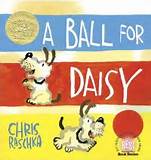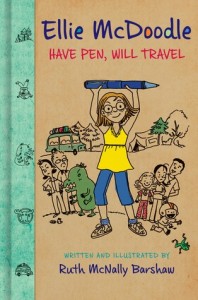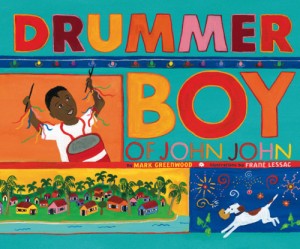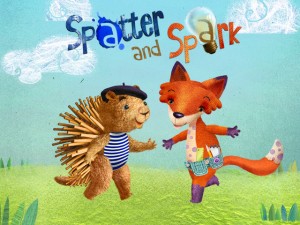A Ball for Daisy and the Power of Wordless Books
 I am super-geeked that I am a guest blogger for Nerdy Book Club. Nerdy Book Club is a great resource, especially for those readers who are hard to match with just the right book. I like their Top Ten lists, like Top Ten Middle Grade Novels featuring Homeschoolers and Top Ten Books featuring Autism Spectrum Disorders. My list of Top Ten Wordless Picture Books will post on March 30.
I am super-geeked that I am a guest blogger for Nerdy Book Club. Nerdy Book Club is a great resource, especially for those readers who are hard to match with just the right book. I like their Top Ten lists, like Top Ten Middle Grade Novels featuring Homeschoolers and Top Ten Books featuring Autism Spectrum Disorders. My list of Top Ten Wordless Picture Books will post on March 30.
In honor of my Nerdy Book Club debut, I’m sharing with you a wordless book that did not make my Top Ten. It’s the Caldecott winner A Ball for Daisy by Chris Raschka. (Why not in my Top Ten? Check out my post on Nerdy Book Club to see which of my favorites nudged this one out!) Daisy loves her red ball. She loves it so much, she even sleeps with it. One day, she and her owner take the red ball to the park to play. Daisy and her owner are playing fetch when another dog chases – and pops! – the red ball. Daisy is heartbroken. But the next day at the park, the other dog’s owner presents Daisy with a new, blue ball. Now Daisy has a new ball to love, and a new friend.
One element of the Common Core Standard of Key Ideas and Details is “retell stories, including key details, and demonstrate understanding of their central message or lesson”. A Ball for Daisy has such a simple plot that this is easy to do. If you’re working on problem/solution, this book works. If you’re working on first/next/last, this book works. And, if you’re looking for ways to build vocabulary, this book works. (How do wordless books build vocabulary? Read my article on ReaderKidZ.) As you “read” this story to your class, use those rich, expressive words. “Daisy looks distraught over the loss of her ball. She is so sad, she is practically inconsolable.” Your students will develop their listening vocabulary and may even use your Scrabble-worthy adjectives themselves as they retell the story.
A Ball for Daisy would be a great Storybox. Put the book along with two dog puppets and two balls in a Storybox and let students act out their retelling. Your students will have a ball!
Read MoreEllie McDoodle: Have Pen, Will Travel
 It’s officially the first day of spring, and yes, we have snow in Michigan. *sigh* I need a good book to lift my spirits, and I’ve found the perfect one: Ellie McDoodle: Have Pen, Will Travel written and illustrated by Ruth McNally Barshaw.
It’s officially the first day of spring, and yes, we have snow in Michigan. *sigh* I need a good book to lift my spirits, and I’ve found the perfect one: Ellie McDoodle: Have Pen, Will Travel written and illustrated by Ruth McNally Barshaw.
Usually I blog about picture books to use with students in preschool through third grade. This book is different; it’s what I call a “highly illustrated novel”, ideal for your second and third graders (also appropriate for those first grade super readers). If you’ve had kids clamoring for Diary of a Wimpy Kid books, give them Ellie. The Wimpy Kid is in middle school, and he’s not a particularly great role model (part of his appeal to the older crowd). Ellie McDoodle has all the cool doodles throughout the book like the Wimpy Kid books, but Ellie is an awesome chick. She’s into nature and drawing so she appeals to boys and girls, and she’s a good kid. This first book in the Ellie McDoodle series has Ellie off on a camping trip with her cousins and her little brother, Ben-Ben. She journals the ups and downs of it all in this book.
We just had Ruth McNally Barshaw come talk to 200 fifth graders who’d studied this book as part of our Battle of the Books. Ruth was phenomenal. Our fifth graders cheered like they were meeting a rock star! They loved this book and are quickly gobbling up the next three books in the series (Ellie McDoodle: New Girl in School, Ellie McDoodle: Best Friends Fur-Ever, Ellie McDoodle: Most Valuable Player – books 5 and 6 are in the works).
So share Ellie McDoodle: Have Pen, Will Travel with your students, especially the author’s note at the end where Ruth describes how to keep a sketch journal. Talking about the information found in the illustrations and how it supports the text is a way to hit the Common Core State Standard of Integrating Knowledge & Ideas. Give the kids paper to make their own mini-journals, and encourage them to doodle, write, and record events from their lives. Even reluctant writers and artists will be drawn in by Ruth’s fun doodle tips also found at the back of the book.
For more information about Ruth McNally Barshaw, please visit: ruthexpress.com.
Read MoreDrummer Boy of John John
 Maybe it’s the vibrant art or maybe it’s the tropical setting of Trinidad, but on this snowy March day, I am in love with Drummer Boy of John John by Mark Greenwood with illustrations by Frane Lessac. Knowing that it’s a biography (so it hits the Common Core standard of Range of Reading) that incorporates music and art makes me love it even more.
Maybe it’s the vibrant art or maybe it’s the tropical setting of Trinidad, but on this snowy March day, I am in love with Drummer Boy of John John by Mark Greenwood with illustrations by Frane Lessac. Knowing that it’s a biography (so it hits the Common Core standard of Range of Reading) that incorporates music and art makes me love it even more.
It’s almost time for Carnival and everyone in Winston’s town is getting ready to celebrate with calypso music. Winston wishes he were in a band, because the best band in the parade will get free rotis from the Roti King. (Is your Craft and Structure Common Core Standard alarm ringing? Lots of interesting word choices in this book!) But Winston has no gourds full of seeds that go “shoush-shap/ shukka-shac” and no bamboo to pound on the ground with a “click clack/ rappa-tap” (Check Print Concepts off on your Common Core score card). When Winston throws his mango pit into the junkyard, he hears a “pong ping pang” as the pit hits old metal. Winston makes his own instrument from the dented metal containers – the first steel drum. Winston’s friends hear this music and form a junkyard band. They paint pots, pans, tins, and cans rainbow colors and experiment with the dents and bumps in the metal to make different pitches. Winston’s band is crowned the best band in the Carnival parade, so they all feast on rotis and mango lemonade.
This book has so many tie-ins for art, music, and social studies. (I wish I’d found it a month ago, so I could’ve used it for Carnival/Mardi Gras, but it’s a fun lesson any time of year.) Students can use recycled cans, jars, bottles and containers to make their own instruments. Paint them in the tropical rainbow colors Lessac used in her art. Play a clip of steel drum music for students (you can get cd’s from your local library or use this Youtube clip: Steel Drums in Trinidad and Tobago. Bring in mangos for students to taste after they try dancing under the limbo pole like the Roti King does. Use your recycled instruments to play a “listen and repeat” rhythm game to build listening skills. Winston Simon began with junk from the junkyard and ended up touring London and Paris with the Trinidad All Stars Percussion Orchestra. Who knows where tin cans and this inspirational book might take your students?
For more information about the author, visit: markgreenwood.com.au.
For more information about the illustrator, visit: franelessac.com
Read More
Spatter and Spark – a free picture book app!
 Perhaps my dilemma is familiar to you. I have an iPad, and I want a great picture book app to share with early elementary students. With my tiny budget I’m always on the hunt for the free, but I also like good stuff, and unfortunately, that combination of free and good is often hard to find. Here’s an app that fits the bill – Spatter and Spark.
Perhaps my dilemma is familiar to you. I have an iPad, and I want a great picture book app to share with early elementary students. With my tiny budget I’m always on the hunt for the free, but I also like good stuff, and unfortunately, that combination of free and good is often hard to find. Here’s an app that fits the bill – Spatter and Spark.
Spatter and Spark is a free picture book app from Polk Street Press. It’s an original story written by the talented and rockin’ cool Deborah Underwood with superb illustrations by Luciana Navarro Powell. Spatter is an artistic porcupine who would like to paint a picture of the baby crow, Hubert, as a gift. The problem is that Hubert is not quite ready to fly down from his nest, so Spatter isn’t sure what Hubert looks like. Spatter asks his inventor pal, Spark, to help him with his problem. She suggests that if Hubert can’t come down, Spatter should go up. Spark invents bouncy shoes for her and Spark to wear and the problem seems solved – until they are bouncing too high! The reader helps to save the day, and that’s one of the best things about apps like this: they encourage reader interaction.
The art for Spatter and Spark is large enough for a whole class to enjoy, but I think it’ll be best used either in small groups or 1-to-1 because readers can help build and paint the bouncy shoes (Spatter is an artist and must make the shoes sparkly!) I love how the shoes we see Spatter and Spark wearing as they bounce are painted exactly the way I chose, a bit of tech magic that delights me. There are activities within the app that can be purchased, but I want to use this with students to talk about Key Ideas and Details.
This story starts with one problem, but one answer doesn’t automatically save the day; the solution leads to another problem. After sharing this picture book app with your students, have them fold or divide a piece of paper into thirds labeled First, Next, and Last (or keep it teched up by using a “show me” app like Educreations to write and draw). In the “First” third, students can show the original problem. In the “Next” third, students can show the solution to that problem, which also caused another problem! In the “Last” third, students can show how that second problem was solved.
Because Spark is an inventor, ask your students to get creative. Bouncy shoes were one way for the friends to get up high – what other ways might there be? Encourage students to draw (or create!) another invention that might work, and make sure to plan for any problems this new solution might cause. In honor of artistic Spatter, students should make the inventions beautiful as well as functional. (Gotta say, I love that the girl is the inventor and the boy is artistic!)
So if you have an iPad 2 or later, and you’re on the hunt for a free picture book that’s also high-quality, download Spatter and Spark!
For more information about Deborah Underwood, please visit: www.deborahunderwoodbooks.com.
For more information about Luciana Navarro Powell, please visit: www.lucianaillustration.blogspot.com.
For more information about Polk Street Press, please visit: www.polkstreetpress.com
Read More







